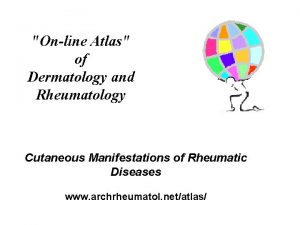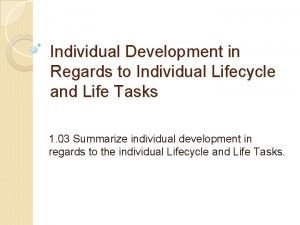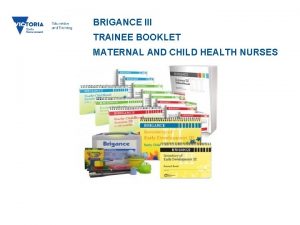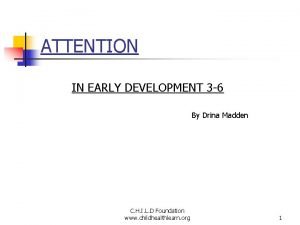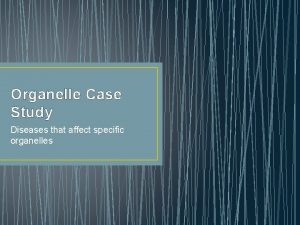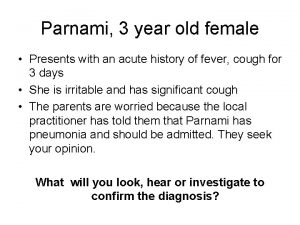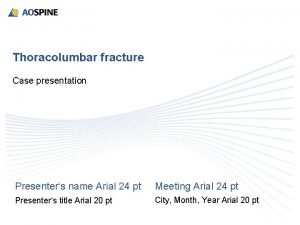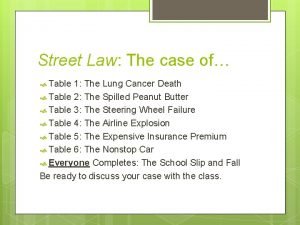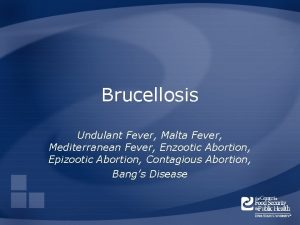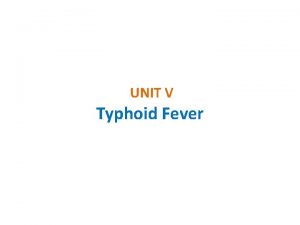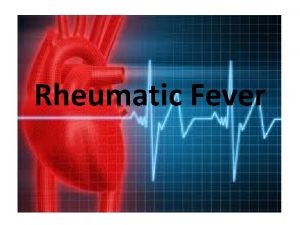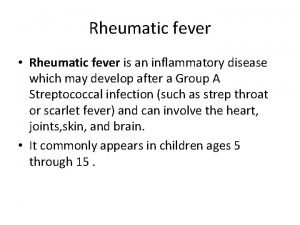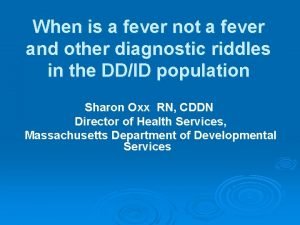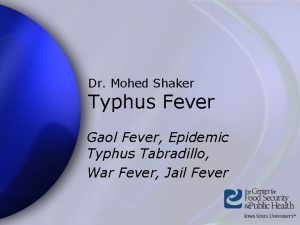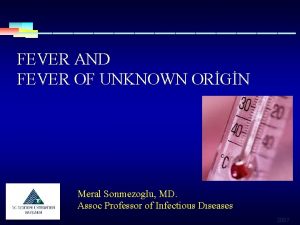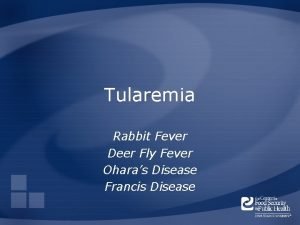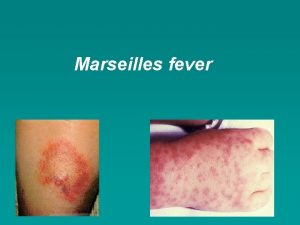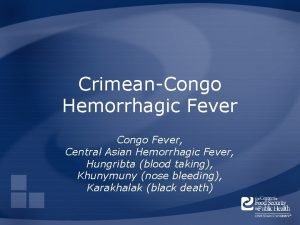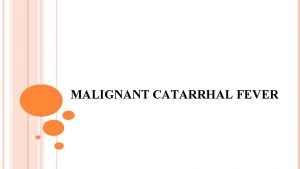A 32 year old man presented with fever


































- Slides: 34

A 32 year old man presented with fever, fatigue, body aches and headache for 1 week. He returned 2 weeks ago from a trip to Egypt.

Typhoid fever • It is an acute febrile disease, caused by Salmonella typhi and S. paratyphi A, B, C • S. typhi and paratyphi lives only in humans. • Persons with typhoid fever carry the bacteria in their bloodstream and intestinal tract. • Carriers recovering from typhoid fever shed S. Typhi in their feces. • It is transmitted through the ingestion of food or drink contaminated by infected people.

Epidemiology ♦ strongly endemic ♦ endemic ♦ sporadic cases

Pathogenesis of Enteric fever - The organisms penetrate ileal mucosa - Reach mesenteric lymph nodes - multiply there. - Invade Blood stream - Infect Liver, Gall Bladder, , spleen, Kidney, Bone marrow. - After 7 -10 days bacilli pass into blood stream (secondary bactermia )

Clinical features • Develop 1 - 3 weeks after exposure. • May be mild or severe. Gradual onset - intermittent fever - malaise, headache - abdominal pain - constipation or Diarrhoea - rose-colored spots on the chest - enlarged spleen or liver. • Healthy carrier state may be follow acute illness.

Rash in Typhoid • Rose spots: 2 -4 mm in diameter raised discrete irregular blanching pink maculae's found in front of chest • Appear in crops of upto a dozen at a time • Fade after 3 – 4 days

Complications • Pneumonia, meningitis, osteomyelitis • Severe intestinal hemorrhage and intestinal perforation • If not treated can be fatal.

Carriers • 5% of the survivors continue to excrete the organism for months = carriers. • In carriers the bacteria remain in the gall bladder and are shed into the intestine.

Investigations • WBC • ESR • Blood, bone marrow, or stool cultures • Widal test (serum agglutination test) cross reactions– false positives

Blood Cultures in Typhoid Fevers • Bacteremia occurs early in the disease • Blood Cultures are positive in 1 st week in 90% 2 nd week in 75% 3 rd week in 60% 4 th week and later in 25%

Differential Diagnosis • • • Brucellosis Tuberculosis Infective endocarditis Lymphoma Adult Still's disease Malaria

Treatment • 3 rd generation cephalosporins, like Ceftriaxone are effective • Flouroquinolones, like ciprofloxacin are the drugs of choice for treatment of typhoid fever. • Fever may continue for several days after starting therapy. • The majority are cured with antibiotics • 10% may relapse.

Prevention and Control (WHO, 2009) Control measures: • Health education • Antibiotic treatment • Excluding disease carriers from food handling. • A vaccine is available recommended for travellers to high risk areas. It does not provide full protection

A 32 year old man presented with fever, fatigue, body aches and headache for 1 week. He returned 2 weeks ago from a trip to Egypt.

Brucellosis • • • Other names: Systemic febrile illness Zoonosis. . occurs worldwide. B. melitensis and B. abortus are most frequent. The incubation period 1 – 4 weeks.

Transmission Infection transmitted to humans by: contact with fluids or meat from infected animals (sheep, cattle, goats, pigs, or other animals) eating food products such as unpasteurized milk and cheese. The disease is rarely, if ever, transmitted between humans.

Pathogenesis • • • Enter the body To lymph nodes To blood stream Reticuloendothelial System Blood Any organ

Clinical Manifestations Often fits one of the three pattern: - Acute febrile illness resembling typhoid. - Fever & acute monoarthritis (hip/knee) - low grade fever, low back pain, hip pain

Clinical Manifestations • Symptoms : Fever, Night sweats, Fatigue Anorexia, Weight loss Arthralgia , Low back pain Depression • Signs: Arthritis lymphadenopathy Hepatosplenomegaly

Localised Brucellosis • Osteoarticular disease: especially sacroileitis, vertebral spondylitis and large joints arthritis • Genitourinary disease, especially epididymo-orchitis • Neurobrucellosis, usually presenting as meningitis, radiculopathy. • Abscess involving the liver, spleen, abdomen.

Differentials • • • Typhoid fever Tuberculosis Infective endocarditis Collagen vascular disease lymphoma

Investigations • WBC • ESR • Blood cultures slow growth = 4 weeks • Serology: SAT positive in recent infection No diagnostic level. . . >1: 360

Treatment • Treatment for uncomplicated Brucellosis – Streptomycin + Doxycycline for 6 weeks – Rifampicin + Doxycycline for 6 weeks – ? TMP/SMX + Doxycycline for 6 weeks • Treatment of complicated Brucellosis – Endocarditis, meningitis – No uniform agreement – Usually 3 antibrucella drugs for 3 months

Relapse • About 10 percent of patients relapse after therapy. • Most relapses occur within three months following therapy and almost all occur within six months. • Relapse should prompt assessment for a focal lesion, especially hepatosplenic abscess • Most relapses can be treated successfully with a repeat course of a standard regimen.

Treated Brucellosis Treatment

A 22 year old student presented with nausea, abdominal pain and diarrhea for 2 days. On examination, he was febrile with mild peri-umbilical tenderness.

Acute Gastroenteritis Defence mechanisms • • Gastric acidity GI peristalsis Normal flora Immune defences

Causes of gastroenteritis • Viruses • Bacteria • parasites

Pathogenesis of diarrhea • • Villous damage Enterotoxin Cytotoxin invasion

Gastroenteritis Bacteria Gastroenteritis • • • Salmonella enteritides Shigella spp. Campylobacter jeujeni Vibrio cholera E. Coli C. difficile

Gastroenteritis • Transmission: contaminated food or drink • Presentation: abdominal pain, nausea, vomiting , diarrhea +/- fever • Diagnosis: stool microscopy & culture • Treatment: fluids PO/IV • Antibiotics: -only for severe cases or impaired immunity - in shigella and cholera

Gastroenteritis Intestinal Amaebiasis • Transmission : by cysts • Causes invasive colitis • Presentation: asymptomatic acute dysentry chronic amebiasis • Complications: liver abscess • Diagnosis: stool microscopy , serology • Treatment: metronidazole

Gastroenteritis Giardiasis: • Transmission: • Colonise upper small intestine • Presentation: asymptomatic – mild to moderate : abd. pain , flatulence • May become chronic • Diagnosis: stool microscopy • Treatment: metronidazole

Food poisoning A. B. C. D. Vomiting within 6 hrs of eating Abd pain , diarrhea after 8 – 16 hrs Abd. Pain , diarrhea after 16 – 48 hrs Abd. Pain, diarrhea , fever 16 - 48 hrs
 Man v society examples
Man v society examples Toddler fever 102
Toddler fever 102 A 41 year old man presents with slow irregular breathing
A 41 year old man presents with slow irregular breathing Once upon a time lived
Once upon a time lived Once upon a time there lived an old man and an old woman
Once upon a time there lived an old man and an old woman Old man and new man
Old man and new man Year 6 poems
Year 6 poems What is a normal resting heart rate for women
What is a normal resting heart rate for women Great gatsby lessons
Great gatsby lessons 42 year old woman
42 year old woman Plep a
Plep a Average height of a 3 year old in centimeters
Average height of a 3 year old in centimeters 9-year-old physical development
9-year-old physical development Long lasting hyphen
Long lasting hyphen Average weight for 8-year-old boy
Average weight for 8-year-old boy 8 yr old girl weight
8 yr old girl weight 9-year-old physical development
9-year-old physical development Brigance test for 4 year old
Brigance test for 4 year old Brigance data sheets
Brigance data sheets One year old marcus turns away in disgust of a bitter
One year old marcus turns away in disgust of a bitter Adhd in 3 year old
Adhd in 3 year old Researchers have sneakily dabbed rouge
Researchers have sneakily dabbed rouge Jerome believes that his 4-year-old grandson
Jerome believes that his 4-year-old grandson Osha tree trimming safety book
Osha tree trimming safety book A steel beam hangs from a cable
A steel beam hangs from a cable Organelle case study answer key
Organelle case study answer key 10 year old sarah stands on a skateboard
10 year old sarah stands on a skateboard Emt chapter 24 trauma overview
Emt chapter 24 trauma overview Beautiful bonsai trees
Beautiful bonsai trees Sti
Sti A 26 year old female presents
A 26 year old female presents 43 year old woman
43 year old woman 27-year old
27-year old Sixteen year old carrie is babysitting
Sixteen year old carrie is babysitting 10 year old sarah stands on a skateboard
10 year old sarah stands on a skateboard









